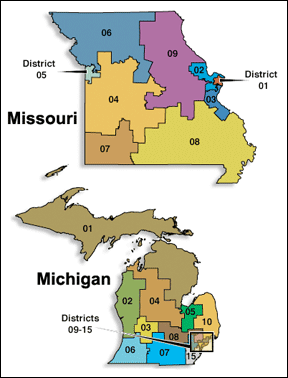Today we turn our attention to the national election between President Barack Obama and former governor Mitt Romney in order to determine each candidate’s path to victory as the political map begins to evolve and change.
It is evident that are there are approximately a dozen battleground states upon which the candidates are focusing. The competitive states considered to be in this swing category include, alphabetically: Colorado (9 Electoral Votes), Florida (29), Iowa (6), Michigan (16), Nevada (6), New Hampshire (4), New Mexico (5), North Carolina (15), Ohio (18), Pennsylvania (20), Virginia (13) and Wisconsin (10).
Last year Obama advisers mapped out five different routes that would secure the minimum 270 Electoral College votes the president needs for re-election. Each path included Obama retaining some, but not all, of the swing states that he won in 2008. As we have seen through nationwide polling data, Team Obama’s strategic tenet in spreading the map as wide as possible is having some effect. Conversely, the Romney brain trust indicates that any realistic course to capturing their identified 270 votes requires them to win back historically Republican states that Obama carried four years ago, such as North Carolina, Indiana, and Virginia.
Each candidate understands the importance of winning the quintessential large swing states of Florida (29 Electoral Votes) and Ohio (18). In 2008, Obama claimed these places and is now spending heavily in hopes of retaining both. Romney advisers see Florida as their candidate’s most important swing state because there is no realistic way to score a national victory without its inclusion. Simply put, Florida’s 29 Electoral Votes are too many to replace.
Currently, several polls reveal Obama as having the edge in Ohio but a recent Gravis Marketing poll of 728 likely voters shows Romney opening up a three-point lead in Florida.
In the past few days two Great Lakes states, Michigan and Wisconsin, are showing signs of teetering toward Romney. Recent polls in both places have returned conflicting results and each candidate can point to data showing him to be in the lead. But even a split decision in August is a positive trend for the challenger.
Michigan, a traditionally Democratic state but one that turned hard for Republicans two years ago, is a place where Romney will heavily contest. A fundamental reason for the strategic decision to do so is his Wolverine State family ties. It is here where the Republican nominee grew up and the electorate twice voted for his father as governor. The Obama senior strategists scoff at the idea that Romney can win Michigan, citing his opposition to the auto bailout and recalling that Sen. John McCain, the 2008 Republican nominee, publicly abandoned the state some six weeks before the election.
Wisconsin, home of vice presidential running mate Paul Ryan, has been trending toward the Republicans in similar patterns to Michigan, cemented by Gov. Scott Walker’s recall election victory earlier this year. With former governor Tommy Thompson running strong in the open Senate race, the Badger State is certainly in play for a close Romney victory.
Early in the cycle we, as most other analysts, suggested that after counting Indiana returning to the Republican camp, Romney would have to carry Florida, Ohio, North Carolina and Virginia, and then one more 2008 Obama state to win the presidency. While such a formula remains valid, the president’s continued performance in Ohio and Virginia suggests that Romney will not likely sweep the four core states. But, numbers coming from the aforementioned Michigan and Wisconsin, and Midwestern and western states such as Iowa, Colorado and possibly Nevada, demonstrates other Republican victory paths are now possible.
Here are the scenarios:
• If the president carries Virginia, a Wisconsin-Iowa combination is the easiest way for Romney to neutralize this Obama core state victory. The Republican would still need one more state, such as New Hampshire, where Obama consistently leads, or Nevada or Colorado to claim national victory. New Mexico, normally a swing state, appears to be currently off the table as the President continues to score double-digit polling leads.
• If Obama wins Ohio, then Romney would be forced to win Wisconsin and Colorado. Under this scenario, Michigan comes into play. Unless Romney carries New Hampshire, Nevada, or Iowa, then the Wolverine State becomes his last neutralization option.
• Should the President carry both Ohio and Virginia, then Romney could still win by taking Iowa, Wisconsin, Michigan, and Colorado or Nevada. All scenarios assume that Romney re-unites Nebraska by winning that state’s 2nd Congressional District and thus providing one more vote to his electoral column.
The overall state chart still favors the president, but the campaign’s recent fluidity suggests several new victory options are now attainable for the challenger.






